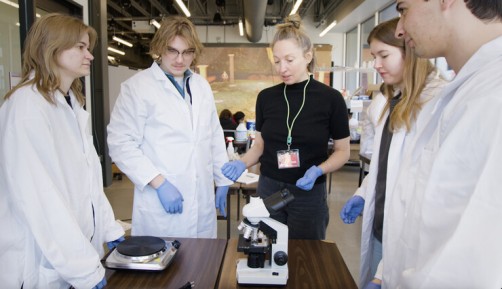Newswise — Edgeworks, a new research and service facility launched by the Johnny Carson Center for Emerging Media Arts at the University of Nebraska–Lincoln, is helping scientists, inventors and entrepreneurs transform cutting-edge concepts into game-changing reality.
Edgeworks is redefining the core research facility model long used in the hard sciences to provide access to talent, technology and expert consultation. Edgeworks provides industry partners and University of Nebraska faculty, researchers and scientists with sophisticated consulting, research and technology development services.
Techniques such as artificial intelligence, virtual reality, game development, augmented reality, data visualization, physical immersive installations and robotics are used to elevate outreach for scientific research, to produce out-of-the-ordinary content with emerging forms of storytelling and to contribute to industry-sponsored research and development.
“We are building an ecosystem at the intersection of media arts and science that will enable new pathways to fuel economic growth in Nebraska,” said Ryan Schmaltz, Edgeworks director. “Edgeworks is attracting projects with opportunities that prepare, attract and retain talent within the state.”
Created with $625,000 from the university’s Nebraska Research Initiative, Edgeworks is the only arts-based core research facility in the state and is among the first of its kind worldwide.
Several partnerships with university faculty are already underway, such as working with Tomas Helikar, Susan J. Rosowski Professor of biochemistry, who created the Digital Twin Innovation Hub to assemble a digital twin of the human immune system; collaborating with Kees Uiterwaal, associate professor of physics and astronomy, to build virtual replicas depicting quantum physics; and partnering with the university’s Rural Drug Addiction Research Center to build an interactive world-building platform aimed at improving the health and wellbeing of rural towns in Nebraska.
Megan Elliott, endowed director of the Carson Center, said Edgeworks will leverage emerging media arts and technologies to strengthen and broaden the university’s already high educational standards, cultivate interdisciplinary research opportunities and engage with Nebraska’s startup communities. The program is part of a growing international network of technological innovation occurring outside coastal metropolitan areas.
“Our faculty are already engaged in national and international research, and this core research facility only amplifies, diversifies and expands our research and innovation abilities and impact,” she said. “This is a very big deal for the state and for our industry.” Edgeworks is actively recruiting more partners, including candidates from the private sector. “Bespoke” projects for industry will create opportunities for students and faculty alike.
“We’re pushing the boundaries of what is possible because of our unique multi-disciplinary approach to creativity, innovation and collaboration,” Schmaltz said. “We are quickly getting a reputation as the place to come for companies, scientific researchers and nonprofits who are tackling hard problems and who want to help shape the future.”
Even though his team’s work to build a computer model of the human immune system is inherently technological, Helikar said Edgeworks’ contribution is critical to its commercialization and its accessibility by clinicians.
“The computer models we’re building are a bunch of equations — they spit out numbers from simulations that nobody but the technical modeling team is going to be able to use,” he said. “How do you present this information to doctors, patients and other end users, so they can use it to make treatment decisions?”
Helikar, who has been working since 2016 to establish the Digital Twin Innovation Hub, was awarded a $5 million, five-year grant through the university’s Grand Challenges initiative in 2022. A multi-disciplinary approach is one of the criteria for the Grand Challenges program.
A draft concept has been developed for how the digital twin interface will appear, and information-gathering focus groups and interviews are being planned. Eventually, there will be a full-time media arts designer to assist with software user experience.
“There are obviously people out there who do this, but for us to hire somebody, we wouldn’t be able to solve the problems they’re solving without the infrastructure through the Johnny Carson Center and Edgeworks,” Helikar said. “I didn’t know what to expect at first. Now we’re headed in a really awesome direction that we wouldn’t have been able to without Edgeworks.”

